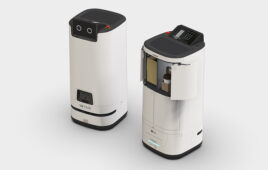|
Listen to this article
|

Ubtech says its humanoid robots can be used in industrial manufacturing, exhibition halls, warehousing and logistics, commercial office services, home services, and college and research institutions. | Source: Ubtech Technologies
Dongfeng Liuzhou Motor, a subsidiary of Chinese automaker Dongfeng Motor Corporation, signed an agreement for UBTECH’s Walker S humanoid robot. The companies did not specify the number of robots that will be deployed or the number of facilities they’ll be at. Additionally, it’s unclear if this is a pilot or if the robots will be officially working at Dongfeng Motor for the foreseeable future.
Since the partnership just [began], our robots need to receive training first, and then they will undertake tasks in the factory soon,” Wenyi Rao, PR manager at UBTECH, told The Robot Report.
The Walker S humanoid will be performing various tasks in the car manufacturing process. These include safety belt inspection, door lock inspection, headlight cover inspection, body quality inspection, rear compartment inspection, interior final inspection, fluid filling, front axle assembly, assembly picking, car logo application, configuration writing, and label printing, a spokesperson from UBTECH told The Robot Report.
DongFeng highlighted that the humanoids will be working with traditional automation equipment, allowing them to handle complex scenarios in unmanned production.
“This will not only bring greater improvement to Dongfeng Motor’s intelligent manufacturing level, but will also become a new style of intelligent manufacturing in the automotive industry, and will accelerate the scene-based and large-scale application of humanoid robots in the automotive industry,” Lin Changbo, General Manager of Dongfeng Liuzhou Motor, told GizmoChina.
Walker S humanoid robot
The Walker S humanoid is 1.7 m tall (around 5.58 feet), and is equipped with force-compliant drive joints and rigid-flexible coupling hybrid structures. The company says these features enable it to walk stable on mobile production lines.
“Walk S is designed for inspection, assembly, and logistics tasks. We aim to enhance manufacturing capabilities and promote humanoid robots in the automotive industry,” Changbo told CarNewsChina.
The robot has 41 servo joints with force feedback, and multiple visual, audio, and distance sensors. These come with multi-model sensor fusion and dynamic environment expiration capabilities. UBTECH says the robot can perceive its surroundings, including humans and objects.
Walker S also includes built-in high-resolution RGBD visual sensors, which allow it to observe the surrounding environment, create 3D semantic maps, and design walking routes while avoiding obstacles.
This year, UBTECH says it has been focusing on deploying its humanoids in several industrial fields, including car and consumer electronic product manufacturing.
“By enhancing the manipulative and task execution capabilities of humanoid robots, we hope to introduce humanoid robots to production lines and factories, bringing the industrial manufacturing process from automation to flexibility, unmanned operation, and intelligent manufacturing,” Wenyi Rao, PR manager at UBTECH, told The Robot Report.
China plans to mass-produce humanoids by 2025
In November 2023, Beijing’s Ministry of Industry and Information Technology (MIIT), which oversees the country’s industrial sector, published a guideline detailing goals for the country’s ambitions to develop humanoids. The MIIT said humanoids were likely to become another disruptive technology, similar to computers or smartphones, that could transform the way we produce goods and the way humans live.
According to the document, China aims to mass-produce humanoids by 2025. To do this, the country aims to establish a humanoid innovation system, make breakthroughs in several key technologies, and ensure the safe and effective supply of core components. The document says that by 2027, humanoids should be an important new engine of economic growth in China.
The Chinese guidelines say industries like healthcare, home services, agriculture, and logistics will likely see a rise in the use of robots in the coming years. The country also wants to put effort into developing humanoids to work in harsh and dangerous conditions and within the manufacturing sector.
Humanoids making their way into automotive
It’s been an exciting year for humanoids within the automotive industry, although the jury is still out on where exactly humanoids will best fit into operations. In January, BMW announced it is testing Figure AI’s 01 humanoid at its Spartanburg, S.C. plant. In the first phase, the company has been identifying the initial tasks its robot could perform. Brett Adcock, Figure’s founder and CEO, said the initial tasks include moving bins and boxes and other “various logistics things” inside the BMW body shop.
Just a few months later, Mercedes-Benz began testing Apptronik’s Apollo humanoid. The companies are identifying applications for the robot. For example, Mercedes-Benz is exploring how well Apollo can bring parts to the production line for workers to assemble, while simultaneously inspecting the components. Apollo will also be tested at delivering totes of kitted parts later in the manufacturing process.
In April, Magna and Sanctuary AI entered into a strategic partnership. Sanctuary said it plans to automate various tasks and to improve the quality and efficiency of its manufacturing and logistics processes.
This likely won’t be the last humanoid to go to work in the automotive industry. Earlier this year, Boston Dynamics unveiled an electric version of its Atlas humanoid. The company says the robot is designed for commercialization. Boston Dynamics is owned by Hyundai, so its parent company may want to eventually try out these robots. In February, Boston Dynamics released a video showing its Atlas humanoid picking and placing automotive struts.






Tell Us What You Think!